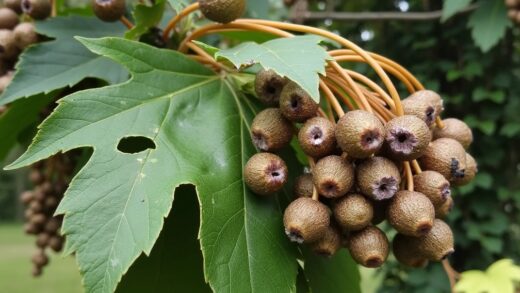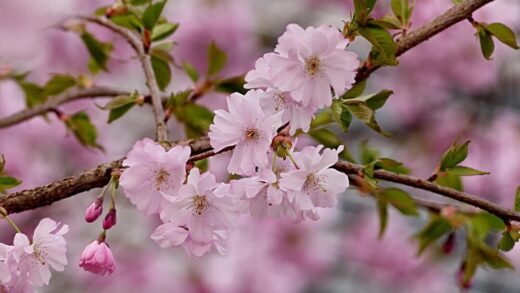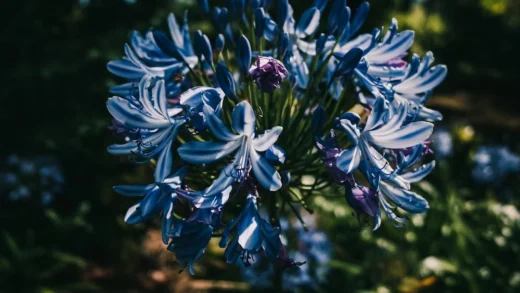Despite being known for its robust nature and commendable disease resistance, ‘The Fairy’ rose is not entirely invulnerable to the common diseases and pests that can affect roses. A vigilant gardener who understands the potential threats and knows how to identify them early is in the best position to keep their plants healthy and thriving. Proactive and preventative measures are always more effective than reactive treatments. By creating a garden environment that promotes plant health—through proper siting, good air circulation, and healthy soil—you can significantly reduce the likelihood of serious problems. However, it is still crucial to be able to recognize the tell-tale signs of trouble and to have a plan for managing any issues that may arise.
The most common challenges for ‘The Fairy’ rose, as with most roses, come from fungal diseases. Black spot, powdery mildew, and rust are the primary culprits, and their development is often heavily influenced by weather conditions, particularly periods of high humidity and moisture. These diseases can disfigure the plant’s foliage, reduce its vigor, and, in severe cases, lead to significant leaf loss, which weakens the plant and diminishes its flowering capacity. Understanding the life cycle of these fungi is key to implementing effective control strategies, which often revolve around sanitation and minimizing leaf wetness.
Insect pests can also pose a threat, ranging from sap-sucking insects like aphids and spider mites to chewing insects that can damage leaves and flowers. While a healthy ‘The Fairy’ rose can often tolerate minor pest activity, large infestations can cause distorted growth, weaken the plant, and detract from its aesthetic appeal. An integrated pest management (IPM) approach, which prioritizes cultural and biological controls over chemical pesticides, is the most sustainable and environmentally responsible way to manage these pests. This involves regular monitoring, encouraging beneficial insects, and using the least toxic control methods as a last resort.
This article will serve as a practical guide to identifying and managing the most common diseases and pests that may affect your ‘The-Fairy’ rose. We will explore the symptoms of key fungal diseases and outline effective prevention and treatment methods. Additionally, we will discuss the identification and control of common insect pests, emphasizing eco-friendly strategies to maintain a healthy balance in your garden. By arming yourself with this knowledge, you can ensure your ground cover roses remain a beautiful and healthy feature of your landscape for years to come.
Identifying and managing black spot
Black spot, caused by the fungus Diplocarpon rosae, is one of the most widespread and recognizable diseases of roses. The symptoms are unmistakable: circular black spots with fringed or feathery margins appear on the upper surfaces of the leaves. As the disease progresses, the leaf tissue surrounding the black spots will turn yellow, and eventually, the entire leaf will drop from the plant. Infections typically start on the lower leaves and move progressively up the plant. Severe defoliation can significantly weaken the rose, reducing its ability to photosynthesize, which leads to stunted growth and poor flowering.
More articles on this topic
The black spot fungus thrives in cool, moist conditions. Its spores are spread primarily by splashing water, from either rain or overhead irrigation. The spores require a period of at least seven hours of continuous moisture on the leaf surface to germinate and infect the plant. This is why preventative measures that focus on keeping the foliage dry are so effective. Water your roses early in the morning at the soil level, using a soaker hose or drip irrigation, to allow the sun to quickly dry any residual moisture. Additionally, providing adequate spacing between plants to promote good air circulation will help the foliage dry faster after a rain shower.
Good garden sanitation is a cornerstone of black spot management. The fungus can overwinter on infected leaves that have fallen to the ground and on any lesions that have formed on the plant’s canes. It is crucial to be diligent about cleaning up and destroying all fallen leaves from around your roses, especially in the autumn. During the growing season, remove and dispose of any infected leaves as soon as you notice them to reduce the number of spores available to spread the disease. In late winter or early spring, during your annual pruning, carefully inspect the canes and prune out any that show signs of purplish or black lesions.
If preventative measures and sanitation are not enough to control the disease, fungicidal treatments may be necessary. A variety of fungicides are available for controlling black spot, including those containing active ingredients like myclobutanil, tebuconazole, or chlorothalonil. For an organic approach, products based on neem oil, sulfur, or potassium bicarbonate can also be effective, particularly when applied as a preventative measure before the disease becomes established. When using any fungicide, it is essential to read and follow the label instructions carefully, ensuring thorough coverage of all leaf surfaces and reapplying at the recommended intervals, especially during periods of wet weather.
Combating powdery mildew
Powdery mildew is another common fungal disease that affects a wide range of plants, including roses. It is easily identified by the characteristic white to greyish, powder-like patches that appear on the surfaces of leaves, stems, and flower buds. Unlike black spot, which requires water to spread, powdery mildew thrives in conditions of high humidity, particularly when days are warm and nights are cool. It is often most prevalent in crowded plantings or in areas with poor air circulation where humidity can linger. An infection can cause leaves to curl, yellow, and become distorted, and severely infected flower buds may fail to open properly.
More articles on this topic
Prevention of powdery mildew begins with good cultural practices. As with black spot, proper spacing of your ‘The Fairy’ roses is key to promoting airflow, which helps to reduce the localized humidity around the plants. While this fungus doesn’t need free water on the leaves to infect, it is still advisable to avoid overhead watering, as this can create the humid conditions that favor its development. Pruning to open up the center of the shrub can also improve air circulation through the canopy. Choosing a planting site with good morning sun exposure will also help to burn off the high humidity that can accumulate overnight.
If powdery mildew appears, there are several effective treatment options. For minor infections, simply pruning out the affected plant parts can sometimes be sufficient. Horticultural oils, such as neem oil, are very effective against powdery mildew. They work by smothering the fungal spores and mycelium. It is important to test horticultural oil on a small area of the plant first and to avoid spraying in hot, direct sun, as this can cause leaf burn. Another popular and effective organic remedy is a spray made from potassium bicarbonate, which changes the pH of the leaf surface, making it inhospitable to the fungus.
For more persistent or severe infections, chemical fungicides may be required. Look for products specifically labeled for the control of powdery mildew on roses. Active ingredients to look for include myclobutanil and propiconazole. As with any chemical control, it is vital to apply the product according to the manufacturer’s directions. It is often necessary to reapply the fungicide every 7 to 14 days during periods that are favorable for disease development. Rotating between different types of fungicides can also help to prevent the fungal population from developing resistance to a single chemical.
Dealing with common insect pests
Aphids are perhaps the most common insect pest you will encounter on your ‘The Fairy’ rose. These small, pear-shaped insects can be green, pink, or black and typically cluster on the tender new growth, such as young shoots and flower buds. They feed by piercing the plant tissue and sucking out the sap, which can lead to distorted leaves, stunted growth, and weakened flower stems. As they feed, aphids also excrete a sticky substance called honeydew, which can attract ants and lead to the growth of sooty mold. Fortunately, aphids are relatively easy to control.
For small infestations of aphids, a strong jet of water from a garden hose is often enough to dislodge them from the plant. This method may need to be repeated every few days until the population is under control. Another effective, low-impact control method is to spray the affected areas with insecticidal soap. This product works by disrupting the cell membranes of soft-bodied insects like aphids but has minimal impact on beneficial insects and the environment. It is crucial to achieve thorough coverage, especially on the undersides of leaves where aphids often congregate.
Another pest to be aware of, particularly in hot, dry weather, is the spider mite. These are not true insects but are actually tiny arachnids. They are very difficult to see with the naked eye, but their damage is more obvious. They feed by sucking the contents out of plant cells, which results in a fine, stippled or speckled pattern on the leaves. In heavy infestations, you may also see fine webbing on the undersides of leaves and between stems. Spider mites thrive in dry conditions, so increasing humidity by hosing down the plant’s foliage periodically can help to deter them. Horticultural oils and insecticidal soaps are also effective controls.
Encouraging natural predators is a key component of a sustainable pest management strategy. Many beneficial insects, such as ladybugs, lacewings, and hoverflies, are voracious predators of aphids and other pests. You can attract these helpful insects to your garden by planting a diversity of flowering plants that provide them with nectar and pollen. By creating a hospitable environment for these natural enemies, you can establish a self-regulating system where pest populations are kept in check naturally, reducing the need for chemical interventions.
Other potential problems: rust and rose slugs
Rose rust is another fungal disease, though it tends to be less common than black spot or powdery mildew. It is most prevalent in areas with cool, moist spring and autumn weather. The disease is easily identified by the small, bright orange or rust-colored pustules that appear on the undersides of the leaves. Corresponding yellow or orange spots may be visible on the upper leaf surfaces. As the disease progresses, the pustules may turn black. Severe infections can cause leaf distortion and premature leaf drop, weakening the plant.
Management of rose rust is very similar to that of black spot. Good sanitation is critical; be sure to clean up and destroy all fallen leaves in the autumn to reduce the amount of overwintering fungal spores. Pruning for good air circulation and watering at the soil level are also important preventative measures. If the disease appears, remove and destroy infected leaves immediately to slow its spread. Fungicides that are effective against black spot, particularly those containing sulfur or myclobutanil, are generally also effective against rust. As with other fungal diseases, early and consistent application is key to successful control.
A common chewing pest of roses is the rose slug, which is not a true slug but the larval stage of a sawfly. There are several species, but they all appear as small, greenish, caterpillar-like larvae that feed on the leaves. They typically feed on the underside of the leaf, skeletonizing it by eating the soft tissue and leaving the network of veins intact. This creates a distinctive, windowpane-like damage pattern. While the damage is mostly cosmetic and healthy plants can usually withstand a minor infestation, heavy feeding can be unsightly and stress the plant.
Controlling rose slugs is often straightforward. Since they are small and feed on the undersides of leaves, they can sometimes be overlooked until significant damage has occurred. Regular inspection of your roses is important. If you find them, they can often be removed by hand and dropped into a bucket of soapy water. For larger infestations, insecticidal soap, horticultural oil, or products containing spinosad are effective controls. These options are less harmful to beneficial insects than broad-spectrum insecticides. By being observant and proactive, you can easily manage these and other potential problems, ensuring your ‘The Fairy’ rose remains a healthy and beautiful part of your garden.




















